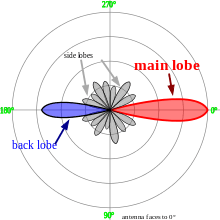Main lobe

| Part of a series on |
| Antennas |
|---|
 |
|
Safety and Regulation |
|
Radiation sources and regions |
|
Antenna Techniques |
The main lobe, or main beam, of an antenna radiation pattern is the lobe containing the maximum power. This is the lobe that exhibits the greatest field strength.
The radiation pattern of most antennas shows a pattern of "lobes" at various angles, directions where the radiated signal strength reaches a maximum, separated by "nulls", angles at which the radiation falls to zero. In a directional antenna in which the objective is to emit the radio waves in one direction, the lobe in that direction is designed to be bigger than the others; this is the main lobe. The other lobes are called "sidelobes", and usually represent unwanted radiation in undesired directions. The sidelobe in the opposite direction from the main lobe is called the "backlobe".
The radiation pattern referred to above is usually the horizontal radiation pattern, which is plotted as a function of azimuth about the antenna, although the vertical radiation pattern may also have a main lobe. The beamwidth of the antenna is the width of the main lobe, usually specified by the half power beam width, the angle encompassed between the points on the side of the lobe where the power has fallen to half (-3 dB) of its maximum value.
See also
![]() This article incorporates public domain material from the General Services Administration document "Federal Standard 1037C" (in support of MIL-STD-188).
This article incorporates public domain material from the General Services Administration document "Federal Standard 1037C" (in support of MIL-STD-188).